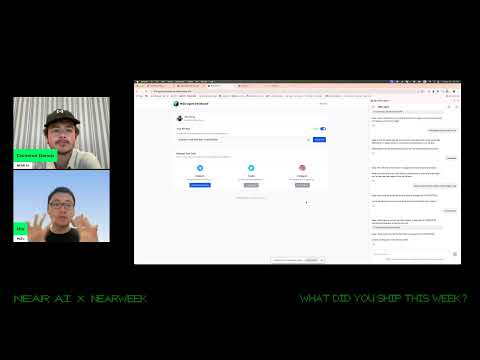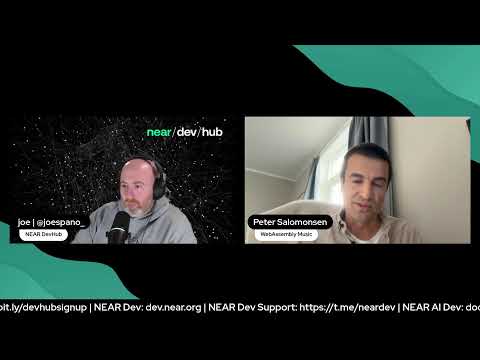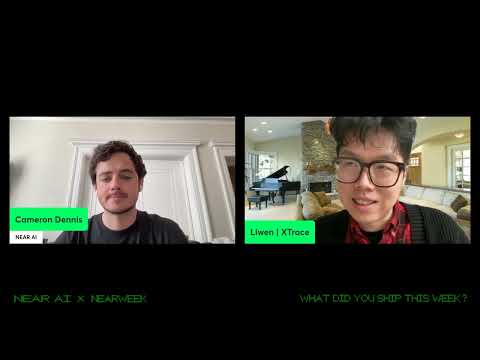New music tools and platforms are popping up on blockchains, like NFTs, music software, Metaverse gatherings, and decentralized streaming platforms. With them, a new type of musician is coming into focus. One exploring novel creative technologies and more equitable revenue streams—on their own terms.
How exactly are musicians navigating Web3 in 2022? Let’s take a closer look at what’s happening on NEAR, where musicians are finding a fast, low cost, and secure blockchain, and an ecosystem of decentralized apps to power their Web3 journey.
New musicians on the blockchain
NEAR x Music (NxM), a guild for musicians and community-building, operates right at the center of blockchain music. Members are already witnessing musicians working in Web3 in several different ways.
Beyond minting NFTs, musicians are using Cryptovoxels, NEARhub, and other virtual or Metaverse spaces for live gatherings. In some cases, musicians use these spaces for music videos and other content.
“There is also more opportunity for musicians to sell their merchandise and music directly to their fan bases rather than depending on platforms as an intermediary,” the NxM Council says. “The blockchain allows you to see who is interacting with and collecting your work.”
Musicians in muti, a creative collective and DAO based in Portugal, are very active on NEAR. Apart from minting audiovisual NFTs, they promote each other’s music and stream original music and DJ sets through their Mutiverse on NEARHub.
“We are working in the digital and physical spaces,” says muti’s Tabea, noting that the collective often organizes events in nature and other non-urban areas. “As NEAR and its platforms develop tools, we’re experimenting with how to integrate the digital with the physical—ticketing, streams from nature into the Metaverse, utility NFTs, etc.”
But, not all musicians are trying to shift the industry paradigm. Some established artists simply want to explore new content distribution and revenue channels.
“Artists are taking advantage of opportunities in Web3 to ride the wave in parallel with whatever they’re already doing in Web2,” says Vandal, founder of DAORecords, a label founded on NEAR.
Origin is a musician and active community member of Amplify.Art, decentralized music platform currently building on NEAR. He points to Cryptopunk rapper Spottie WiFi, real name Miguel Mora, as an artist completely committed to blockchain music. Like David Bowie’s Ziggy Stardust or Damon Albarn’s cartoon band Gorillaz, Mora’s Spottie WiFi persona is an artistic avatar. A cryptovoxel purpose-built for Web3, Spottie WiFi partakes inNFT releases and Metaverse performances.
Other artists, like Emily Lazard, FiFi Rong, and even Deadmau5—who released the NFT single “this is fine” on NEAR—already have sizable followings. For them, Web3 helps grow their audiences and revenue.
“What’s most attractive about Web3 is the independence and control to do whatever you want,” says Origin. “What’s so interesting and exciting is the way you could combine any artform, be it poetry, sculpture, photography, video, graphic design, music, and spoken word into an NFT.”
Like other musicians exploring music NFTs, Origin is excited about the opportunity to earn more per release. With Web3, one neeedn’t make homogenous music just to get millions of streams.
Building and using music software
Musicians will also find new blockchain music software on Web3. And if they have the developer chops, they can design it.
Chiptune musician and developer Peter Salomensen developed WebAssembly Music, a live coding music and synthesizer in Javascript/AssemblyScript (WebAssembly) on NEAR. With WebAssembly Music, Salomensen has minted music NFTs and made them remixable. He also released a piano roll interface for short, editable music NFTs, on which musicians can create and publish their own music.
Endlesss, a Digital Audio Workstation (DAW), gives musicians the instruments and tools to produce music collectively. Founder and developer Tim Exile, a former Warp Records music producer, is on a mission to unbundle music from a product produced by professionals and consumed by the masses.
With the Endlesss app (iOS, MacOS, Windows), music becomes a collective journey. Musicians collaborate live or asynchronously in “Jams”. Think of them as “musical chat groups” in which participants create, share, and remix short bits of songs called “Rifffs”, short bits of songs. Artists share Rifffs that musicians or even fans can then remix and sample, which evolve over time like a musical exquisite corpse.
“That’s why we built Endlesss—to be collaborative and real-time so that it’s conversational,” says Exile. “Every step along anyone’s musical journey from creation, to curation, to discovery, to listening is one that brings you into contact with people.”
Call it the gamification of music collaboration and remix culture. As Exile notes, games aren’t prescriptive. Each level or an entire game can be completed in any number of ways, which is the goal of Endlesss..
“As you jam together, you build an entire history of everything that happened in that jam,” Exile explains. “So, it’s music creation as storytelling because as the jam evolves you listen to how the music evolves.”
“The first thing we’re building on NEAR is to share those Jams with an audience or other creators, and allow people to collect individual Rifffs as NFTs,” Exile adds.
In the future, Vandal expects tighter integration between music software and blockchain platforms. DAWs that could, for instance, export music files directly as minted NFTs.
“You could even mint the stems when you click ‘master’,” says Vandal. “I’ve seen a few products out there shifting over to Web3, and it’s going to be great as a creator when it’s all integrated into the hardware..”
One Endlesss community member even created a hardware controller for the music software. While it’s a proof-of-concept, it demonstrates how hardware could be integrated with blockchain software.
Reinventing remix culture and collaboration
The “Amen break,” a drum break found in countless 20th and 21st century recordings, is perhaps the most famous sample in music history. Best estimates suggest it has appeared on at least 5,500 songs. And yet the drummer who laid down the track, “G. C.” Coleman, a member of the 60s funk and soul band The Winstons, never got a penny from it. Coleman is a cautionary tale of sampled works: that while sampling can lead to great artistic works, the original creators deserve fair compensation.
The music industry clamped down on sampling after The Beastie Boys seminal album Paul’s Boutique (1989). Now, sample clearance can and often does stifle creativity by making it cost-prohibitive.
With blockchain technology, sample clearance and royalty payments could be made easier and cheaper for musicians. Artists and labels could simply make music available to musicians for sampling and remixing through smart contracts, cutting out middlemen, and allowing a new era of sample-based creativity to bloom. While a boon for new musicians, Vandal isn’t sure how this will impact older music that artists want to sample.
“It’s hard to say whether older music will be re-released to include on-chain splits to facilitate royalties,” Vandal says. “If it does, it could positively impact the future of sampling.”
To nurture remix culture, Endlesss will launch a marketplace with a smart contract that features a “remix royalty” for creators. The NEAR blockchain is unique in that a royalty function is baked in at the protocol level, unlike other chains where it can only be added after the fact.
“So, if someone buys a Rifff and starts a new Jam, then the participants in the Jam from which that Riff was purchased will collectively get a royalty,” he says. “Whether that royalty will be 60%, 20%, 80% is hard to say. I have no idea what people will feel is right.”
“The secret part of remix culture has always been recontextualizing,” says Exile. “It’s context to the power of 2: that’s actually where the value gets created. Splice is all-you-can-eat samples, and Spotify all-you-can-eat music, which is great for commodities but bad for culture because it commodifies it. Culture is all about meaning, purpose, and uniqueness, and I would say that all-you-can-eat and culture are incompatible.”
Exile also sees something else fascinating in blockchain-based sampling and remix culture. With smart contracts, musicians and listeners can trace sample attribution through layers upon layers of creation, like descending Wikipedia-style rabbit holes.
This just doesn’t happen with Web2 music software and streaming platforms. In Web3, musicians can be part of a new renaissance in music culture.
“There’s a golden opportunity to monetize culture through meaning rather than commodification,” says Exile. “This is how it should be, I think.”
Redefining the record label and royalties
Labels are facilitators—this won’t change in Web3. But, those labels that wish to operate in Web3 will have to rethink how they function.
“Record labels will most likely be DAOs, providing funding, support, resources, and even minting NFTs and performing other services to artists, as needed,” says Vandal. DAO labels can offer shared ownership, transparency, and a blockchain-inspired business model that appeals to artists.
Amber Stoneman, founder of Minting Music, a music-first NFT production and promotion company, says musicians under contract already have labels managing their NFT releases. Minting Music helps these labels, or artists that decide to forego labels, build NFT marketplaces.
In song publishing, there are multiple forms of ownership. Someone can own the overall master recording, while over 20 other individuals or entities can own rights to lyrics, composition, recording, and more. Song catalogs are bought out from under musicians and sold over and over again.
“In the Web2 space, musicians don’t know who owns their music or where it’s at,” says Stoneman. “We’ve never had technology like the blockchain to track things so clearly and transparently.”
“An artist can sell an NFT and it could make X amount of dollars, and they have just a few creator wallets connected to that smart contract, and the royalty splits are happening in real time,” she adds.
Artists will also be able to easily claim their copyrights in cases of dispute by using NFTs and on-chain data. Muti’s smokedfalmon says listeners and fans could also tip artists for their work.
Both muti’s Tabea and DAORecords’ Vandal believe simplifying royalty payouts with smart contracts will make artists more open and willing to collaborate and create work together. “Fractionalization of the publishing pie with fans or early investors is also an exciting possibility,” says Vandal.
“This is a plus from the community side of things, as Web3 can help in shifting the decision-making,” Tabea says. “It allows a collective, agency, or artist to use a DAO to not only hold and receive funds but integrate the wider community. So, fans and supporters can actually vote on decisions towards the future of the DAO/project, if the collective wants that.”
Creators and community are the future
With blockchain, the future of music is the creator. But no musical creator will exist in a silo or vacuum. Musicians can and will be more integrated with communities. New ones will pop up, morph, evolve, and die, becoming the seeds for new artistic communities.
“The creator proposition is in building, owning, and curating your identity in collaborating with others, on your own terms,” adds Endlesss’ Exile. “And the dynamics will propel people along those collective journeys.”
“Doing this work on NEAR over the last year with guilds and DAOs has given me confidence that I’ve chosen right,” says Vandal. “Community is everything,” Vandal says.
What needs to happen, in his opinion, is a true understanding of decentralization’s power. Sure, the new musician can leverage blockchain for their own benefit, but its capacity for community-building and engagement is potent. This, Vandal believes, can put the music industry on the path to revolution.
“It is definitely an exciting time for musicians,” he says. “We are history in the making.”
Check out the complete series on Blockchain Music:
Part 1: Music and Blockchain: Introducing the Future of Sound
Part 2: Building a Record Label on the Blockchain
The post Music and Blockchain: The Rise of the New Musician appeared first on NEAR Protocol.

 Technology4 days ago
Technology4 days ago
 Technology4 days ago
Technology4 days ago
 Technology4 days ago
Technology4 days ago
 Technology4 days ago
Technology4 days ago









